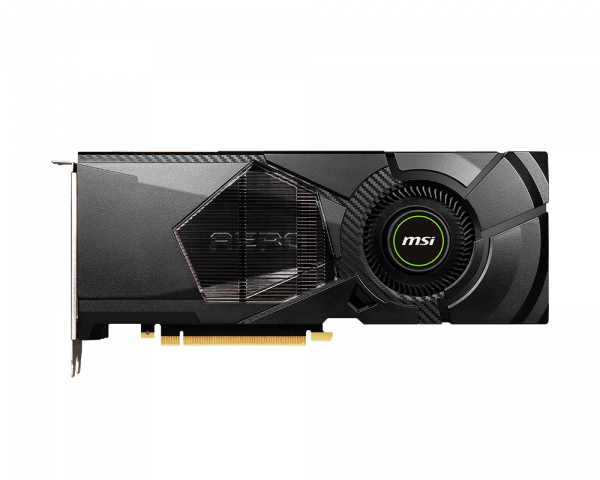
Weíre still in one of the most crushing GPU shortages in history and itís not just thanks to scalpers and silicon shortages. Cryptocurrency miners have long been the bane of enthusiast and professional GPU customers who simply canít find cards to buy or, at least, find them at anywhere near MSRP. They have also turned the used GPU market into a minefield, since ex-mining GPUs are usually close to their useful end after being run 24/7 at full tilt for months on end.
Nvidia have recently tried to crack down on crypto miners gobbling up cards like the RTX 3060 by crippling mining performance in the drivers. Of course, a software fix will inevitably be worked around, so the company has also released dedicated mining cards such as the CMP 50HX. MSI has been one of the first board partners to release this sweet spot mining card, so weíre going to take a closer look at it in particular and the whole range of CMP cards in general.
Under the Hood of the CMP 50HX
The CMP 50HX sports 3584 CUDA cores, 10GB of GDDR6 and a 320-bit memory bus. The card will work optimally for mining even on a PCIe 1.0 interface with four lanes. Nvidia hasnít said which GPU the CMP 50HX is based on, but it seems to be a Turing-based chip. Tomís Hardware speculates that itís the TU102 recycled and cut down. Thatís the same chip youíll find in a 2080 Ti, but presumably with the ray-tracing hardware removed.
In terms of performance, the 50HX is rated for 45MH/s when it comes to its Ethereum hash rate. Thatís under room temperature with adequate cooling.
Other cards in the range are also available, with a 90HX at the top of the pile and the 30HX and 40HX filling out the bottom half of the range.

Mining-specific Hardware Features
Apart from not having an artificial driver-based performance cap, why would you want to use one of these cards instead of a mainstream CPU? Has Nvidia done anything to make them more appealing to miners?
We presume that the drivers for CMP cards are optimized for mining in order to achieve the advertised hash rates, but Nvidia have also built the card to operate in an environment where a single CPU is controlling a large number of cards. Thatís not the case with mainstream GPUs which have moved away from supporting multi-GPU setups on anything but top-tier cards.
Board partners are also designing their CMP cards for the mining environment. In the case of the MSI card, the lack of rear panel connectors has allowed the company to repurpose the entire back of the card as a giant exhaust. The fan is also a dual bearing design meant to run 24/7 for years without failing. The same canít be said about gaming GPU fans that are designed to only operate at full tilt for short bursts.

The other big issue is power consumption. In the case of the 50HX the rating is 225W TDP, but weíll have to see actual cards in computers to measure the actual power draw. Energy use is critical in mining, since thereís little point in paying more in electricity than the cards generate in revenue.
Pricing and Availability
Cards like MSIs 50HX havenít received official announcements or any fanfare. Nvidia has an official page for the range of GPUs, but thereís nothing about price. These cards arenít going to be sold to just anyone and we assume miners will have to apply for access.
ASUS, Colorful, EVGA, Gigabyte, MSI,Palit and PC Partner are all confirmed as being onboard to supply CMP cards. So it does seem like Nvidia is planning to have more than enough supply to help revive its mainstream GPU business customerís enthusiasm.
Pricing is going to be key as well, since these cards are not to be sold in the open market, they should not be subject to scalping and wild fluctuations.
Uses Besides Mining
Nvidia already sells GP-GPU cards in the form of the Tesla cards, although these have now been renamed to Nvidia Data Center GPUs. Itís hard to know at this point what the fundamental difference is between mining GPUs and data center GPUs, but we assume that the CMP cards donít have any of the machine learning tensor cores left over. Since they donít serve much of a purpose in mining at this point.
Still, if CMP cards are significantly cheaper than data center cards, there are still plenty of computational jobs that you only need CUDA cores for. Which may make them attractive to some non-mining customers. However, Nvidia will probably be very careful about who they sell to and limit the drivers in some fashion. Most of the details are still up in the air, but weíll watch this space with interest.
What About ASICs?
Arenít ASICs (Application-specific Integrated Circuits) a better option for mining? These purpose-built mining computers are certainly much better when it comes to hashes-per-watt and often even outright speed, but they have many drawbacks as well. For one thing, they are REALLY specific. Usually ASICs can only hash one or a very small subset of crypto algorithms. So if a particular coin becomes unprofitable you might as well throw away all the hardware you bought. With CUDA cores you can switch to essentially any algorithm. Even ones that donít exist yet. While there is still a place for ASICs, it is clear from GPU demand that more than enough miners prefer the flexibility and long-term relevance of general-purpose cards.
Hereís hoping that dedicated mining cards are enough to sate their hunger and leave mainstream gaming and professional cards alone.